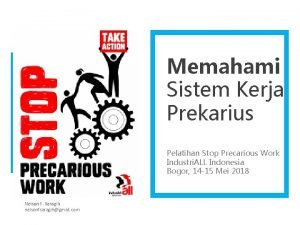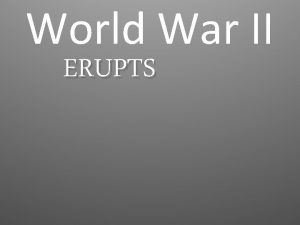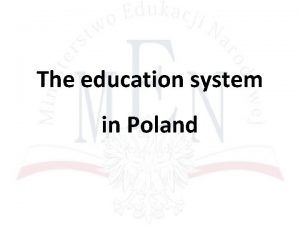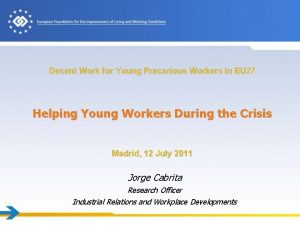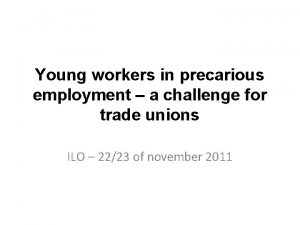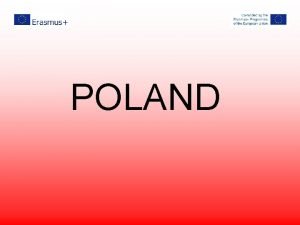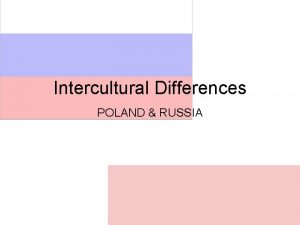Young precarious workers in Poland the experiences of













- Slides: 13

Young precarious workers in Poland: the experiences of work and the patterns of coping with the capitalist transformation Dr hab. Adam Mrozowicki Institute of Sociology, University of Wroclaw adam. mrozowicki@uwr. edu. pl

Overview • Introduction • Precarity East and West: approaching precarity in Poland • Trade union and social movement responses to precarity • Life strategies and orientations to civic activism of young workers • Conclusions • More information: www. prework. eu (!)

Introduction • The central puzzle: rise of precarious work after systemic change in Poland combined with limited labour protests • Why had young workers not protested against the rise of precarity? • How to explain from worker-centred perspective the (gradual) emergence of counter-movements in the last decade? • The (biographical) limits to the normalisation of precarity (Lorey 2016) and the political consequences of new movements against precarity? • Empirical basis: • PRECARIR project (VS/2014/0534, EC DG Employment) – 21 expert interviews • PREWORK project (DFG/NCN Beethoven, UMO-2014/15/G/HS 4/04476) – 40 biographical narrative interviews in PL (tentative thematic analysis) + CATI module (J. Gardawski, N=1000) – first descriptive results

Precarity East and West: the case of Poland (I) • Precarious employment – work for remuneration characterized by uncertainty, low income, limited social benefits, statutory entitlements and collective voice (Vosko 2010, p. 2) • The context of fragmentation of encompassing institutions typical of post-WWII arrangements some elements missing in post-socialist Eastern Europe • The embeddedness of precarity (Hardy 2016) • Structural embeddedness of precarity: as the relationship between precarity, and spatiality and dynamism of capitalism linkages with the nature of systematic transformation and semi-peripheriality of Poland producing constant demand for skilled, flexible, low paid workers

Precarity East and West (II) • Institutional embeddedness of precarity – its evolution in the context of policies and regulations adopted: three waves of precarisation • 1 st wave of precarisation: shock therapy, the re-emergence of unemployment, “pensioners’ welfare state” (Bohle and Greskovits) and the myth of the market • Limited “voice” (protests) and the dominant “loyalty” strategies (entrepreneurship) • 2 nd wave of precarisation: legal changes aimed at increasing labour market flexibility in the context of high unemployment in early 2000 s, the preparation for Poland’s accession to the EU and the goal of attracting FDIs; increasing weakness of industrial relations actors and institutions (UD=12%, CBC=15 -25%) • the “loyalty” strategies (educational boom) and “exit” strategies (migration) – in both cases affecting young people • 3 rd wave of precarisation: economic slowdown (2008+) used to stabilize and reinforce earlier policies despite good economic performance • Political changes in 2014 -15 in the wake of presidential & parliamentary elections: the outburst of the (young) “precariat anger”? From ‘exit’ and ‘loyalty’ towards ‘voice’? (Meardi)

The expanding zone of temporary work Economically active population in Poland aged 20 -29 by the type of activity 100% 90% 80% 70% 60% 50% 40% 30% 20% 10% 0% 1999 2000 2001 2002 2003 2004 2005 2006 2007 2008 2009 2010 2011 2012 2013 2014 2015 Employers Self-employed without workers Contributing family members Temporary employed Other employed (incl. open ended) Unemployed Source: Eurostat LFS, Mrozowicki & Karolak 2016 (PREWORK WP 2 Report)

Weakness of traditional union protests Days not worked due to industrial action, comparing 1990 s with 2000 s days not worked per 1, 000 employees 350 1990 -1999 2000 -2009 300 250 200 150 100 50 0 ES FR DK IT BE FI wa NO IE AT sa LU CY UK MT RO HU SE SI PT DE NL PL LT SK EE CH LV Source: ETUI, Kurt Vandaele 2016, Strikes in Europe, http: //www. etui. org/Topics/Trade-unionrenewal-and-mobilisation/Strikes-in-Europe-version-3 -July-2016

Counter-movements against precarity? • Agential embeddedness of precarity – related to workers’ responses • Problems of union structural weakness and limited institutional resources • Problems of union legitimacy and identity: searching for new topics&tools • Weakness of social movement unionism (except for small radical unions) • Main observations of the PRECARIR project in Poland: • • Bricolage unionism (Maciejewska&Mrozowicki 2017): ad-hoc solutions Union organising (not targeting young people, but covering them in some cases) Some (rather weak) radical unionism / SMU examples Union discursive power, social campaigns against “junk contracts” Shift towards legislative solutions and political coalitions Externalisation of problems (Greskovits 2015) to international sphere Traps of political coalitions (e. g. Solidarnosc / Law and Justice cooperation) • New actors on the scene: cooperation with feminist movements, new leftwing party (Razem) and local alliances with nationalists

The limits of normalisation: quantitative view Satisfied Neither dissatisfied nor satisfied Dissatisfied 0 10 20 30 40 50 60 70 On the whole how satisfied are you with living in your country? (%) On the whole how satisfied are you with the present state of the economy in Poland (%) Now thinking about the Polish government, how satisfied are you with the way it is doing its job? (%) Source: The research on representative sample of the Polish youth in WP 3 of the PREWORK project, informants aged 18 -30, November. December 2016, CATI, N=1000, carried out by IQS. The questionnaire was designed by Professor Juliusz Gardawski 80

Civic activity in qualitative PREWORK sample, N=47, %) Representative CATI results - less active • 4, 3% - joined political party • 12, 2% - joined an NGO • 29, 7% - signed online petition • 13, 3% - took part in a demonstration Activity in political party Activity in trade union Activity in social movement Activity for local community Still: higher levels of activity than 10 -15 years ago (2001: 33% active; 2015 – 44%) Activity in NGO Contibuting to charity Joining demonstration Voluntary activity Online petition 0 5 10 15 20 25 30 35 40 45 50

Life strategies and civic participation (I) • Pilot study in Wroclaw (N=24; 2013): • market-liberal type – individualism, self-directedness, entrepreneurship, choice for flexible contracts, criticism of unions as not fitting market reality • reformist type – insecurity combined with aversion of corporate careers, moral rejection of junk contracts, criticism of union bureaucracy • withdrawn type – precarity considered transitory situation, lack of interest and knowledge about unions • PREWORK study (2016 -2019): further elaboration of reformist type • Biographical limits of flexibility (social bonds, public services, planning) and moral rejection of ‘junk contracts’ • Technical difficulties of organising and worker individualism: majority non-unionised • Pragmatic and autotelic motives of support of unionism

Life strategies and civic participation (II) • Technical and cultural barriers to traditional unionisation Adam: I mean, the very idea of trade union is really dear to my heart, but… this world in which I work is really blurred as far as competences are concerned, as I said, we are to do everything and nothing, so it would be difficult for me to build any group of, for instance, trade union, around such work (…) I think it’s too utopian vision and a kind of political representation than a union it’s more likely to be effective. • Autotelic meaning of activism and new coalitions Daniela: I really needed it. Something which would allow me to fulfil myself, to develop outside work to which it is difficult to commit yourself (…)Afterwards, I got engaged in the grassroots Trade Union Workers Initiative, because in the 8 th March Initiative there were people who were its members and we started Milieu Committee and this is how it started. • Anti-establishment values – new nationalist movements Asia: I have rather right-wing views. Well, I take part in some demonstrations, like the Independence March, or celebrations of the Day of Cursed Soldiers, I take part in such historical things. But (…) the more I hear about politics, the more I feel that it doesn’t make sense (…) It really hurts that instead of transmitting some other values, they will say that other demonstrations are not allowed, that there is cross and Kaczyński and not that there was war and that our soldiers died for us to have it better. • Creating new political representations – new left wing party Marcin: It was probably after my third contract in Warsaw that I decided that I should do something and I joined Together party. Unfortunately, due to the lack of time, I have no time to participate in all of this (…) I am stay as passive member. But perhaps I will renew it one day. Because I’m not so much angry, but I imagine that this can be a movement in which something can be done. I mean, the party.

Conclusion • Theoretical and political puzzle: the emergent criticism against precarity following its normalisation in the post-socialist context • The need for further biographical analysis of the motives and choices of young people which make some of them less prone to accept precarisation • Various framing of the criticism: precarious workers, angry citizens or disillusioned national community members • There is a space for unions: technical and cultural barriers to traditional unionisation at the workplace level might be overcome by novel approaches, but there is a danger of hijacking labour agenda by other, not always democratic forces

